| Temperature and Precipitation Trends Brownsville, Harlingen, McAllen, in 2014 Cool weather with periodic precipitation prevailed for the first half of 2014, but warm and relatively dry weather returned for summer. The year would close on a wet note, with substantial September rainfall for a second year in a row that quenched at least short term water thirst for much of the Rio Grande Valley. The charts below show monthly temperature averages (left, line charts) and precipitation departures from the 1981–2010 average (right, bar charts) through the year. Averages and departures are based on the data sample of record, which dates back to 1878 for Brownsville, 1953 for Harlingen (Valley Airport), and 1961 for McAllen (Miller Airport). January through May were generally below the long term average for temperature, marking seven consecutive months below average dating back to November 2013. Summer (June through August) was slightly above average, before temperatures danced above and below average from September through December. Temperatures for the year would end close to or slightly below average for the Rio Grande Valley as a whole, though McAllen, at a little over 1°F above average, bucked the area value, which was closer to 0.5° below average. 2014 would be the coolest year in the Rio Grande Valley since 2010. Notable were the departures from average precipitation to close out the year; September’s tropical moisture pushed totals above average at many locations near the Rio Grande, including pockets with more than fourteen inches of rain. November also dropped heavy rainfall on many locations; some locations in northeast Kenedy County received more than 7 inches; the populated areas of the Rio Grande Valley received generally 3 to 5 inches for the month, roughly 2 to 4 times average. The helpful rainfall across the Rio Grande Valley in 2014 was not necessarily a boon for Falcon International Reservoir. Unlike in 2013, when multiple events in July and September brought levels back from the brink, the lack of substantial tropical rain producers in the tributaries that feed Falcon International Reservoir kept levels from recovering further. Slow winter rises due to near zero evaporation and some incoming flows were not enough to bring levels back to those at the end of 2013, and remained 10 points lower than the 1990-2014 mean (30 percent versus 40 percent of conservation, Texas share). The remnants of eastern Pacific Hurricane Odile were gobbled up by Amistad International Reservoir, which closed 2014 above 65 percent conservation (Texas share), their highest since the drought impacts began in earnest in late 2011. So, while the high soil moisture was more good news given the alternative (another dry year with potential for widespread public water emergencies), there remains concern if and when another prolonged drought develops, and the resulting stability for agricultural and municipal needs later in 2015 as of this writing. |
|
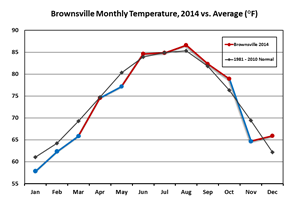 |
 |
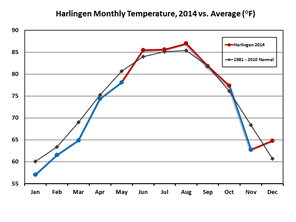 |
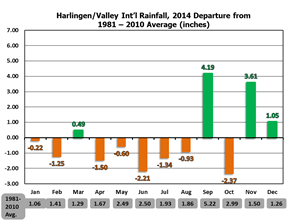 |
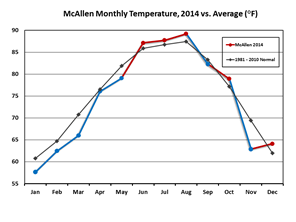 |
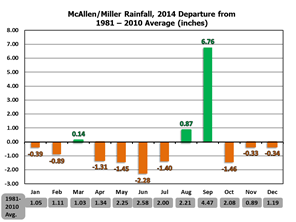 |